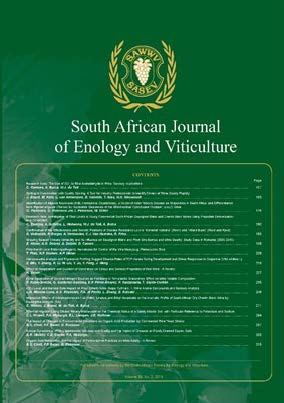Organic Acid Metabolism and the Impact of Fermentation Practices on Wine Acidity - A Review
DOI:
https://doi.org/10.21548/39-2-3172Abstract
The conversion of grape sugar to ethanol and carbon dioxide is the primary biochemical reaction in alcoholic wine fermentation, but microbial interactions, as well as complex secondary metabolic reactions, are equally relevant in terms of the composition of the final wine produced. The chemical composition of a wine determines the taste, flavour and aroma of the product, and is determined by many factors such as grape variety, geographical and viticultural conditions, microbial ecology of the grapes and of the fermentation processes, and the winemaking practices. Through the years, major advances have been made in understanding the biochemistry, ecology, physiology and molecular biology of the various
yeast strains involved in wine production, and how these yeasts affect wine chemistry and wine sensory properties. However, many important aspects of the impact of yeast on specific wine-relevant sensory
parameters remain little understood. One of these areas of limited knowledge is the contribution of individual wine yeast strains to the total organic acid profile of wine. Wine quality is indeed very directly linked to what wine tasters frequently refer to as the sugar–acid balance. The total acidity of a wine is therefore of prime sensory importance, and acidity adjustments are a frequent and legal practice in many wineries. However, the total acidity is the result of the sum of all the individual organic acids that are present in wine. Importantly, each of these acids has its own sensory attributes, with descriptors ranging from fresh to sour to metallic. It is therefore important not only to consider total acidity, but also the
contribution of each individual acid to the overall acid profile of the wine. This review will summarise the current knowledge about the origin, synthesis and analysis of organic acids in wine, as well as on the
management of wine acidity.
Downloads
Downloads
Published
Issue
Section
License
A copyright form will be e-mailed to the corresponding author when the manuscript has been accepted for publication.
In principle, the Author agrees to the following when he/she signes the copyright agreement:
I hereby assign to the SOUTH AFRICAN SOCIETY FOR ENOLOGY AND VITICULTURE (SASEV) the copyright of the text, tables, figures, supplementary material, illustrations and other information (the Material) submitted with the manuscript to be published in SOUTH AFRICAN JOURNAL OF ENOLOGY AND VITICULTURE (SAJEV) (the "Article"). The copyright becomes effective from the date the Article has been accepted for publication in SAJEV.
This is an open access journal, and the authors and journal should be properly acknowledged, when works are cited.
Author's may use the publishers version for teaching purposes, in books, theses, dissertations, conferences and conference papers.
A copy of the authors' publishers version may also be hosted on the following websites:
- Non-commercial personal webpage or blog.
- Institutional webpage.
- Authors Institutional Repository.
The following notice should accompany such a posting on the website: This is an electronic version of an article published in SAJEV, Volume XXX, number XXX, pages XXX - XXX, DOI. Authors should also supply a hyperlink to the original paper or indicate where the original paper (www.journals.ac.za/index.php/sajev/) may be found.
Authors publishers version, affiliated with the Stellenbosch University will be automatically deposited in the University's Institutional Repository SUNScholar.
Articles as a whole, may not be re-published with another journal.
The following license applies:
Attribution CC BY-NC-ND 4.0

